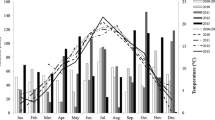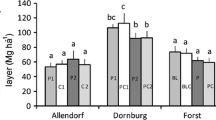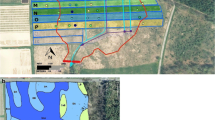Abstract
Incorporating nitrogen-fixing cover crops into short rotation woody crop (SWRC) plantations may increase soil and tree nitrogen while sustaining, or even improving, yields. This study examined the impacts of Trifolium pratense L. at different seeding rates on soil and poplar N and poplar growth when alley cropped in a one-year old plantation for 2 years compared to natural vegetation and a bare-soil control. These vegetation types were applied in the field under a wide (3.05 m) and narrow (1.82 m) tree alley width. Results showed two of four variations including red clover had 151% and 222% higher soil NO3− levels compared to controls in the second year (wide spacing/full seed rate and narrow spacing/half seed rate, respectively). This correlated with a 26% and 23% increase, respectively, in poplar leaf N concentrations compared to controls. At the wide spacing and full clover seed rate, poplar foliar P was 80% lower compared to controls, implying significant competition. However, results also showed the potential to mitigate this effect with wider tree spacing and lower cover crop seeding rates, without compromising nitrogen benefits. Although higher foliar nitrogen levels did not correlate with increased poplar productivity within 2 years, the results of this study suggest nitrogen-fixing cover crops can improve soil and poplar nitrogen and may sustain SWRC nitrogen requirements over one or multiple rotations.

Similar content being viewed by others
References
Araujo ASF, Leite LFC, Iwata BF, Lira MA, Xavier GR, Figueiredo MB (2012) Microbiological process in agroforestry systems. A review. Agron Sustain Dev 32:215–226
Banks ML, Kennedy AC, Kremer AC, Eivazi F (2014) Soil microbial community response to surfactants and herbicides in two soils. Appl Soil Ecol 74:12–20
Calfapietra C, Gielen B, Karnosky D, Ceulemans R, Mugnozza GS (2010) Response and potential of agroforestry crops under global change. Environ Pollut 158:1095–1104
Ceotto E, Candilo MD (2010) Sustainable bioenergy production, land, and nitrogen use. In: Lichtfouse E (ed) Biodiversity, biofuels, agroforestry and conservation agriculture. Sustain Ag Rev, vol 5. Springer, Dfordrecht, pp 101–123
Chhin S (2010) Influence of climate on the growth of hybrid poplar in Michigan. Forests 1(4):209–229
Dupraz C, Simorte V, Dauzat M, Bertoni G, Bernadac A, Masson P (1998) Growth and nitrogen status of young walnuts as affected by intercropped legumes in a Mediterranean climate. Agrofor Syst 43:71–80
FAO (2012) Planted forests. http://www.fao.org/forestry/plantedforests/en/. Accessed 22 Nov 2016
FAO (2015) World fertilizer trends and outlook to 2018. http://www.fao.org/3/a-i4324e.pdf. Accessed 22 Nov 2016
FSC (2012) strategic review on the future of forest plantations. Indufor, pp 1-8
Gamble JD, Johnson G, Sheaffer CC, Current DA, Wyse DL (2014) Establishment and early productivity of perennial biomass alley cropping systems in Minnesota, USA. Agrofor Syst 88:75–85
Gelfand I, Sahajpal R, Zhang X, Izaurralde RC, Gross KG, Robertson PG (2013) Sustainable bioenergy production from marginal lands in the U.S. Midwest. Nature 493:514–517
Gruenewald H, Brandt BKV, Schneider BU, Bens O, Kendzia G, Hüttl RF (2007) Agroforestry systems for the production of woody biomass for energy transformation purposes. Ecol Eng 29:319–328
Høgh-Jensen H, Schjoerring JK (2000) Below-ground nitrogen transfer between different grassland species: direct quantification by 15 N leaf feeding compared with indirect dilution of soil 15N. Plant Soil 227:171–183
ITTO (2009) Encouraging industrial forest plantations in the tropics—Report of a Global Study, Issue 33 of ITTO technical series. International Tropical Timber Organization
Jose S (2009) Agroforestry for ecosystem services and environmental benefits: an overview. Agrofor Syst 76:1–10
Kremer RJ, Kussman RD (2011) Soil quality in a pecan-kura clover alley cropping system in the Midwestern USA. Agrofor Syst 83:213–223
Kröger M (2012) Global tree plantation expansion: a review. ICAS review paper series 3:1–24
Lamerre J, Schwarz KU, Langhof M, Wühlisch GV, Greef JM (2015) Productivity of poplar short rotation coppice in an alley-cropping agroforestry system. Agrofor Syst 89:933–942
Lesuffleur F, Salon C, Jeudy C, Cliquet JB (2013) Use of a 15N2 labelling technique to estimate exudation by white clover and transfer to companion ryegrass of symbiotically fixed N. Plant Soil 369:187–197
Miller RO (2016) Developing an algorithm to predict single-tree biomass weight from stem diameter measurements in young hybrid poplar energy plantations in Michigan. Forest Biomass Innovation Center Research Report
Munroe JW, Isaac ME (2013) N2-fixing trees and the transfer of fixed-N for sustainable agroforestry: a review. Agron Sustain Devel 34:417–427
Penn State University Extension (2007) Management of red clover as a cover crop. https://extension.psu.edu/management-of-red-clover-as-a-cover-crop. Accessed 25 Jan 2017
Pirhofer-Walzl K, Rasmussen J, Høgh-Jensen H, Eriksen J, Søegaard K, Rasmussen J (2012) Nitrogen transfer from forage legumes to nine neighbouring plants in a multi-species grassland. Plant Soil 350:71–84
Purwin C, Sienkiewicz S, Pysera B, Lipiński K, Fijałkowska M, Piwczyński D, Puzio N (2014) Nitrogen fractions and amino acid content in alfalfa and red clover immediately after cutting and after wilting in the field. J Elem 19:723–734
Silvestri N, Giannini V, Antichi D (2018) Intercropping cover crops with a poplar short rotation coppice: effects on nutrient uptake and biomass production. Ital J Agron 13:934
Snapp SS, Swinton SM, Labarta R, Mutch D, Black JR, Leep R, Nyiraneza J, O’Neil K (2005) Evaluating cover crops for benefits, costs, and performance within cropping system niches. Agron J 97:322–332
R Core Team (2016) R: a language and environment for statistical computing. R Foundation for Statistical Computing, Vienna. https://ww.r-project.org/. Accessed 20 Sept 2016
Thilakarathna MS, McElroy MS, Chapagain T, Papadopoulos YA, Raizada MN (2016) Belowground nitrogen transfer from legumes to non-legumes under managed herbaceous cropping systems. A review. Agron Sustain Dev 36:58
Van Sambeek J, Ponder F, Rietveld W (1986) Legumes increase growth and alter foliar nutrient levels of black walnut saplings. For Ecol Manag 17:159–167
Waring HD, Snowdon P (1985) Clover and urea as sources of nitrogen fore the establishment of Pinus radiata. Aust For Res 15:115–121
Wilson AR, Nzokou P, Cregg B (2010) Ground covers in fraser fir (Abies fraseri [pursh] poir.) production systems: effects on soil fertility, tree morphology and foliar nutrient status. Eur J Hortic Sci 75:269–277
Author information
Authors and Affiliations
Corresponding author
Additional information
Publisher's Note
Springer Nature remains neutral with regard to jurisdictional claims in published maps and institutional affiliations.
Electronic supplementary material
Below is the link to the electronic supplementary material.
Rights and permissions
About this article
Cite this article
Shults, P., Nzokou, P. & Koc, I. Nitrogen contributions of alley cropped Trifolium pratense may sustain short rotation woody crop yields on marginal lands. Nutr Cycl Agroecosyst 117, 261–272 (2020). https://doi.org/10.1007/s10705-020-10068-8
Received:
Accepted:
Published:
Issue Date:
DOI: https://doi.org/10.1007/s10705-020-10068-8




